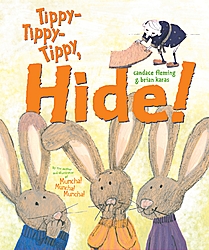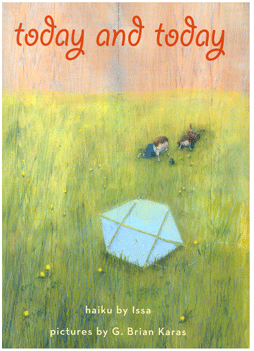The “G” Stands for Ginormously* Talented . . .
 July 31st, 2007 by jules
July 31st, 2007 by jules
I love G. Brian Karas’ work as an illustrator, his relaxed lines and the warmth and humor that seeps from his work with his signature sketchy style. I always look forward to seeing his new titles. Here’s a short post about two of his illustrated titles from this year that I’ve been wanting to write about for what seems like forever now. (Karas also illustrated the just-released How Many Seeds in a Pumpkin? by Margaret McNamara — Random House, July 2007. Review to come) . . . And if you’re a fan of Karas as I am, well, we at 7-Imp might just have a treat for you a couple weeks from now.

by Candace Fleming
and illustrated by G. Brian Karas
Ginee Seo Books (Atheneum)
January 2007
(library copy)
Mr. McGreely and those three little bunnies are back (having debuted in Muncha! Muncha! Muncha! in 2002). McGreely is looking forward to a peaceful winter, but those bunnies are determined to get inside: “‘Ah,’ he sighed. ‘Time to snuggle in for winter.’ But . . . Tippy-tippy-tippy, pat. Knocka-knocka-knocka.” Yup, here they come. And, even though he slams the door in their wee bunny faces, nails the mail slot shut, plugs the chimney up, boards up all the windows, and bricks in both his doors (he’s mad, I tell ya), you can’t keep those bunnies out. Well, maybe just a little. And, well, you’ll just have to let the plot unfold for you when you read it, but I will say that Fleming brings things full-circle with a pleasing “Muncha, muncha, muncha!” to close out the book.
The sharp comic timing of Fleming and Karas is on display again in this follow-up title, though not as tight as with the prequel. There’s a whole heapin’ dose of humor, lots of lively onomatopoeia (making this one a good read-aloud choice), and even some bunny drops. And Karas’ depiction of yet another rabbit-induced rage for Mr. McGreely is funny stuff. I love his maniacal squiggly-lined mouth when he’s hopped up on his bunny hateration. I love how Fleming doesn’t feel like she has to make his heart get all soft on us in the end in an ABC AfterSchool Special kind of way. He is who he is. Just give him his space, thanks very much. Even at the close of Muncha! Muncha! Muncha!, he’s doing his victory dance at having “beat{en}the bunnies!” — mwahahahahahahaha — and then, in the final illustration, is simply resigned to sharing carrots with them. They surely aren’t holding hands, singing “kumbayah,” which plenty of other writers would feel compelled to bring us in the name of Feel-Good. Three cheers for McGreely and his Grumpy Old Man misanthropism! Funny stuff — for children and adults alike.

haiku by Issa
and illustrated by G. Brian Karas
Scholastic
March 2007
(library copy)
 Star! Star! One of the most beautiful picture books I’ve seen this year. This is an anthology of poetry by Kobayashi Issa, a Japanese poet of haiku, born in 1763. Karas kicks things off with a passionate “word from the artist”: “In my artwork, I have tried to achieve visually what Issa achieves with words, to convey the precise feeling of each moment so that someone else might feel it, too. The buzz of a hot summer day or big wet snowflakes hitting your face–it is ordinary, extraordinary moments like these, strung together, that make up our lives.” And, with that, he really succeeds in this title.
Star! Star! One of the most beautiful picture books I’ve seen this year. This is an anthology of poetry by Kobayashi Issa, a Japanese poet of haiku, born in 1763. Karas kicks things off with a passionate “word from the artist”: “In my artwork, I have tried to achieve visually what Issa achieves with words, to convey the precise feeling of each moment so that someone else might feel it, too. The buzz of a hot summer day or big wet snowflakes hitting your face–it is ordinary, extraordinary moments like these, strung together, that make up our lives.” And, with that, he really succeeds in this title.
Karas chose and arranged eighteen of Issa’s haiku to tell the story of the year in the life of a fictional family, divided into seasons (and each illustration that announces the next season is depicted with cherry blossoms). And this is, hands down, Karas’ best work ever. I can’t even pick a favorite spread; there are so many (though the summer spread with “the cicada’s song/ the gentle breeze” — with Karas’ very thick and texturized style of painting and striking use of yellow — is probably the most outstanding). Depicting loss and renewal in the death of the young children’s grandfather (all shown via the illustrations — and the powerful presence of an empty chair — created with rice paper, wood planks, paint, and pencil) and then return to spring and all its life, there’s a lot of tenderness here (and even a nod to Van Gogh) — and poignancy that never once crosses over into maudlin. The poems do not all follow the traditional haiku structure, but there is a child-like simplicity to Issa’s work that really makes this translate well, so to speak, for the picture book format. And thank goodness Karas decided to do so, because it’s one of the most gorgeous picture books I’ve seen this year.
The Horn Book review wrote, “Like haiku, Karas’s art captures moments in time and conveys, with color and light, sensory detail such as the look and feel of a hot summer night or a bright autumn morning. This contemplative and lushly illustrated picture book will be useful in classrooms, with the storytelling aspect of the poems and art adding a new dimension to the usual study of the haiku form.” See also Elaine’s review from February at The Blue Rose Girls’ site and David’s review at the excelsior file.
Really, go treat yourself to this gem of a picture book.
* Now an official word — at least according to Merriam-Webster . . . besides, if you read this, we Yanks are just slow in getting to it anyway.

Jules,
I had a feeling you’d like Today & Today. I think it’s a very special book. I love what Karas did with the poetry and art. I’m a Karas fan, too. Muncha! Muncha! Muncha! was a favorite read-aloud book in my library.
Mine too, Elaine! Muncha-x-3 never failed in storytime. And the kids would be chanting “Muncha muncha muncha…” all the rest of the afternoon.
And Jules – “hopped up on his bunny hateration” is maybe the funniest line you’ve ever written.
jules, your posts always make me long for the picture book days of my kids’ youth. Not that they (or I) can’t read them all NOW, but you know how it is. One day, I’m just going to plop myself down on the floor of the library and do nothing but soak myself in picture books again.
Thanks, all.
Sara, what a nice compliment. Thank you. And, yeah, I’m 35, and picture books are my favorite thing — next to liquer-filled chocolates and the coffee bean! I’m a big believer in teens being shown some of the more sophisticated picture books, too (Today and Today is a great example of one). When I was the librarian at the School for the Deaf (in Knoxville), which serves pre-K to 12, I used to tell the teens that — that adults love them, too, and that they’re never too old for the merging of text and art that is a picture book.
I am continually amazed at the disdain so many adults have for children’s lit and picture books, in particular. Which is why I often ask authors or illustrators about it in our interviews (that and the fact that people assume children’s book authors live in little pink bubbles, as Jack Gantos put it once). I am afraid I might seem obsessed by the question/the issue, but it always astounds me how much disdain is heaped upon the literature and pursuits of and interests of and everything-else-for-children in this country. Sara, do you ever feel like some adults tune out when you say you’ve written a children’s book?
Sorry, I’m getting off topic. It just saddens me how quickly so many people write them off, when — as an art form — I think the picture book is endlessly fascinating. Another topic for another day, I guess.
Thanks again. I can easily see you sitting on the floor, submersing yourself in picture books. I would think, as a poet, that you would have a particular appreciation for the fact that, as with a poem, every word matters so very much in picture books. In fact, have you ever thought about writing one?
I’m really done now. (See what happens when the grandmother is playing with the girls — I leave novellas for comments) . . .
“Have you ever thought about writing one?” Oh, Jules, I would love to, only because having a talented artist like G. Brian Karas illuminate my words would be like heaven. I love partnerships in art (as in the theater) and I love leaving room for another creative person to come in and play. I really wanted some interior art in Letters From Rapunzel, and I’m going to be begging for some in my next book. But frankly, I don’t have enough experience in the picture book genre to even attempt it. I don’t think I’d be good enough. And there’s too much excellence out there already.
As to the “tuning out,” I don’t get that, usually. I think because so many people talk about or dream about writing a children’s book, they tend to want to pump me for info instead. But I do often find a complete lack of understanding about children’s novels. People think ALL books for kids are picture books. I think these might be people who didn’t read as kids? Or whose kids don’t read now?
Anyway, I completely agree about picture books as art, and that’s why your posts are always reminding me of all the beauty I’m missing.